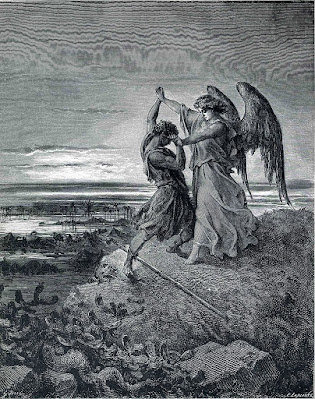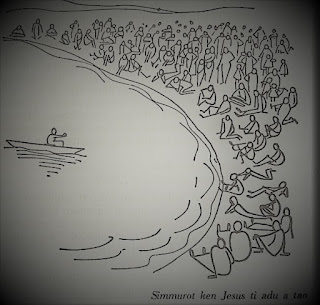Wrestling with the Angel
 |
| Wrestling with the Angel (Gustave Doré 1855) |
*From a section of an article which I wrote in 2016 for Orientis Aura: Macau Perspectives in Religious Studies. The footnotes do not appear here.
The Wrestling with an Angel at the Ford of Jabbok (Gen 32:23-32)
The story of Jacob at the ford of Jabbok is centered on the theme of wrestling. Besides the play on words in Hebrew of the names, “Jacob” (yaʿăqōb) and “Jabbok” (yabbōq); and the verb “wrestle” (wayyēʾābēq), the literary structure indicates the same. Previous to this night incident, the main preoccupation of the narrator is the encounter between Jacob and his brother Esau (Gen 32:1-22) which would happen after twenty years (or after four chapters in Genesis), after Jacob has to escape from his brother for stealing both the bekōrāh (birthright) and the berākāh (blessing).
Esau hates his brother and even publicly swears that he is going to kill his brother (cf. 27:41). This long-expected meeting of brothers is full of suspense then. Jacob is said to be “greatly afraid and distressed” (32:8, NRSV). So he prepares a series of gifts to appease Esau, using even the former’s own family as a buffer (32:13-21).
The narrative, however, breaks up at this point, connected only with what it precedes with the temporal indicator, ballaylāh-hahûʾ (on that night, vv. 21b, 22a). That same night, Jacob gets up (qûm), and together with his two wives, two servant-girls, and eleven children cross the ford of Jabbok (v. 22). The change of setting—from Mahanaim (v. 2) to Jabbok and Jacob’s action in this intervening narrative form a contrastive inclusion: “The sun rose upon him as he passed Peniel, ‘limping’ (ṣālaʿ) on account of his hip” (v. 31). The story then can stand independently having a plot of its own—from setting to the outcome, with the wrestling scene as the climax.
Literary Structure
Following Westermann, the narrative has this literary design:
I. Setting (vv. 23-24)
II. Attack, a man wrestled with him (v. 25)
III. Outcome of the fight
A. Opponent’s request to let him go (vv. 26a-27a)
B. Jacob’s counter, condition, request for the name (vv. 27b-30a)
C. Opponent refuses name, blesses Jacob (v. 30b)
IV. Jacob names the place (v. 31)
V. Change of setting and etiological explanation (v. 32).
Who Is Jacob's Opponent?
To highlight this incident, the narrator informs that Jacob is left alone (v. 24a). His opponent is described initially as “man” but whom the readers, later on, understand as God (ʾĕlōhîm, v. 28; cf. 12:3-5). The fight lasts long—“until the break of dawn” (ʿad ʿálôt haššāḥar v. 24) but produces no clear winner.
It is at this point that the mysterious opponent turns out to be the antagonist as he cheats on Jacob” he strikes (nāgaʿ) on the latter’s hip socket and becomes dislocated. The narrator seems to amuse his readers with Jacob, the trickster, now becoming the tricked; the cheater, the cheated. Jacob nonetheless holds on to the fight, ironically in an honest way; he does not employ similar dirty tactics. The opponent has to beg him to release the former for the day is breaking. In reply, Jacob demands, “I will not let you go unless you bless me” (32:26b, NRSV).
Thus, as Esau demanded that his father should bless him (27:34,38) so does this younger brother. The opponent does not accede immediately to the request. Instead, he asks Jacob’s name then changes it to “Israel” with an etiological explanation: “for you have wrestled [śārāh] with God [ʼĕlōhîm] and humans and were able [yākōl]” (32:28b).
At this point, the narrator reveals the identity of the opponent to his readers. Jacob himself is not surprised to hear of the divine revelation but asks the latter’s name instead -- as if he did not just wrestle with God. God does not reveal his name but blesses Jacob. At this moment also, Jacob understands the identity of his opponent as he names the place “Peniel” also with an etiological explanation, “For I have seen God face to face, and yet my life is preserved” (v. 30, NRSV); the narrator plays on the words penîʾēl (Peniel), ʾĕlōhîm (God), and pānîm ʾel-pānîm (face to face); and later on penȗʾēl (Panuel), the place where the limping Jacob/Israel crosses over when the sun shines (v. 31) The narrator closes this section with another etiological explanation about Israelites not eating the thigh muscle (gîd hannāšeh) on the hip socket because of this incident (v. 32).
As it is, the narrative itself is self-contained, with a clear plot rising to a climax. On a closer look, however, there are lacunae so that not very few readers would describe the story as enigmatic. Who is Jacob’s nemesis – God? An Angel? Why can the divine being not winning over Jacob? Why should the former resort to trickery? Why must the divine being disappear at daybreak? What is the connection between Peniel and Panuel? What is the purpose of this breakaway narrative in the whole story of Jacob?
Mythological Elements
While the observation of Fishbane is correct as to the literary function of this narrative in Jacob’s Cycle, the mythological elements of the narrative are also obvious. Westermann in fact relegates it to the Elohist Source and proffers the idea that at the heart of the narrative is a common theme in ancient folklore of a man encountering a non-benevolent spirit guarding a river and that to cross that river one must overcome the “river-demon.” That explains why the river-demon is afraid of the light.
The suggestion could not explain though why the pious narrator must employ a river-demon genre for his religious saga that concludes with the etiological naming of a sacred place and a holy people. The Hebrew word “Elohim” in some instances does not mean “God” but could refer to a divine being, i.e., angel. Sarna for example thinks that Jacob’s opponent is not God but an angel given the previous narrative on the malʾākê ʾĕlōhîm (angels of God) who meet the patriarch at a place which is a maḥānê ʾĕlōhîm (the camp of God) and thus named maḥănāyim (lit. two camps, vv. 1-2).
With the previous narrative on the encounter of Jacob with the angels of God in Bethel (28:10-22), it forms an inclusio. In those stories, Jacob is alone and the divine encounter happens at night. In Bethel, Jacob is running away from his brother Esau; In Peniel, he is returning to his estranged brother.
In any case, the wrestling with God or an angel is not unprecedented in the Hebrew Bible.
The story could be an “echo” of the much earlier and the more popular Epic of Gilgamesh as far as the ancient Near East is concerned. The hero Gilgamesh is endowed with an extraordinary strength but is an arrogant and oppressive king. The gods decide to make another Gilgamesh who will subdue the former. Enkidu is formed from clay and from the saliva of a goddess making him both human and divine. Both men come to a wrestling match. Gilgamesh prevails but the effect of that fight makes him a new person: he stops oppressing his people, begins to perform worthwhile tasks, and even befriend Enkidu.
The theme of the physical fight including wrestling with a deity is also not foreign in Greek mythologies. Heracles (Hercules) must wrestle with Antaios, the giant. The latter forces all those who pass by his land to a wrestling match. The giant defeated them all and used their skulls to roof the temple of his father Poseidon. Ironically, Antaios draws his invincible strength from her mother Gaia, Earth. When Heracles challenges him in the ring, he is advised to lift the giant up from the earth in the contest. He does so and the giant weakens and thus is defeated and killed. On another occasion, Heracles wrestles with Thanatos, the god of Death, thus saving a queen’s life. In both cases, Heracles’ victory transforms the world to be a safer place for humankind to live.
The Hero with a Thousand Faces
The hero facing such kind of trials may remind one of the well-known quotes from The Hero with a Thousand Faces (first published in 1949). In the Introduction, Joseph Campbell writes:
“A hero ventures forth from the world of common day into a region of supernatural wonder: fabulous forces are there encountered and a decisive victory is won: the hero comes back from this mysterious adventure with the power to bestow boons on his fellow man.”
Campbell thinks that most myths follow a common plot of a journey of a hero unfolding in three stages: the call to adventure, the road of trials, and the return to the ordinary world; or departure-initiation-return an insight based on Arnold van Gennep’s The Rites of Passage.
Wrestling with the Divine as Initiation
It is not hard to discern a similar pattern with Jacob’s wrestling with God in Peniel. Jacob who earlier on is a fugitive, an aimless wanderer, is called to a task to inaugurate a new nation to be called “Israel” and thus must come to this threshold and prove himself worthy of the task.
This initiation of the hero demands the abandonment of the old world that he lived symbolized by superseding that mystical fight and coming out a new man, prepared to commence his God-given mission. Jacob’s metanoia is illustrated neatly by the narrator moving from the physical to the moral: Jacob comes out from the fight permanently disabled, he receives a name that denotes his mission.
In the stories that come later, Jacob who now is Israel is a new man: no longer is he obsessed of cheating and lying but is now exceedingly generous and reconciliatory: he insists that Esau must accept his gift; allows his brother and his caravan to journey ahead of him; and repeatedly calls his brother ʾădōnî, “my Lord” (33:8,13,14,15).
It is said that in Tibetan Buddhism the Second Buddha Padmasambhava, who is credited for the spread of Buddhism in Tibet, would wrestle with mountain deities, one by one, mountain by mountain; and once he pins them down and prevails over them, the Second Buddha makes hear his endless lectures—for months, years, even centuries. Then the deities would get sick of the talks and give in: “Okay, I guess the Dharma is useful. Buddhism is helpful.” As in the Jacob story, the deities lose in the game; but unlike in the former, it is the deities who get converted
It is not surprising then that in some early Christian writings, the metaphor of mystical wrestling was used to underscore the seriousness and tediousness of the preparation to receive the sacraments of initiation notably baptism In his First Instructions to Catechumens, John Chrysostom, preaching in the late fourth century in Antioch (Syria), tells the candidates that the thirty days of the period of preparation for baptism is just like going to a wrestling school, where one learns to defeat the “evil demon.”
It is only through wrestling with this evil demon that one can come out prepared for baptism:
"So then, in your case these thirty days are like some wrestling school, both for exercise and practice: let us learn from thence already to get the better of that evil demon. For it is to contend with him that we have to strip with him after baptism are we to box and fight. Let us learn from thence already his grip, on what side he is aggressive, on what side he can easily threaten us, in order that, when the contest comes on, we may not feel strange, nor become confused, as seeing new forms of wrestling; but having already practiced them amongst ourselves, and having learnt all his methods, may engage in these forms of wrestling against him with courage."


Comments
Post a Comment